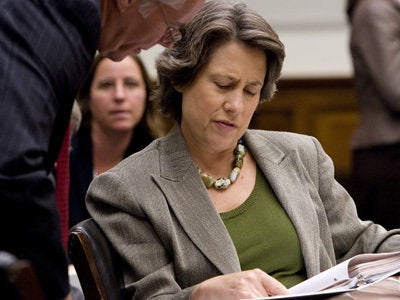
Contrary to popular belief, the Public-Private Investment Program, a centerpiece of the government's strategy to rescue the nation's banks, is not dead.
The PPIP may be in critical condition, but the FDIC is planning what it hopes will be a miracle cure--a new pilot program it will launch in July to unload toxic assets under the supervision of new advisers who will structure and oversee the sale to qualified investors, the agency told the Huffington Post.
The new pilot is similar to the original PPIP that failed so spectacularly earlier this month, when banks resoundingly refused to sell any toxic--or err, um, "legacy"--assets to private investors. But this time around, rather than the banks unloading toxic debt from their balance sheets, it will be the FDIC that sells its own hard-to-price assets, which it acquired when it seized failing banks.
The program could establish a price floor for illiquid toxic assets, which have so far been nearly impossible to value. This could have an impact on those banks that have till now avoided pricing these assets for fear the transparency will force further write-downs, rendering some of them insolvent.
"We want to test the funding mechanism that we were contemplating for banks with PPIP, to get a structure in place so that if the program is needed down the road, we are prepared," Joseph Jiampetro, a senior FDIC advisor, told the Huffington Post. He added that the agency is currently hiring several advisers to structure the deal, find qualified investors and oversee the sale.
The original PPIP, or Public-Private Investment Program, was launched in March to enable banks to rid themselves of risky, valueless debt. Under the program, banks could unload subprime mortgages and other loans that have lost value in the recession to private investors.
To entice these investors to buy the risky debt, the FDIC agreed to offer them cheap financing to fund the purchases--an amazing 6-to-1 deal. Still, the program collapsed recently when banks refused to lower the prices of these assets sufficiently to interest the investors. Or perhaps, some say, it was the fear of pricing transparency that could have led to hits on their balance sheets.
There was also concern that Treasury Secretary Tim Geithner, who was key overseer of the program, would impose limitations on those who participated in PPIP. Since calling for restrictions on banks that accessed TARP funds, Geithner has had a chilly relationship with the private sector. This time around, however, oversight of the pilot program will shift to FDIC Chair Sheila Bair, a Republican who is admired by Wall Street.
"The private sector is a lot more comfortable with Sheila Bair and the FDIC than they are with Tim Geithner and the Treasury," said Dan Greenhaus, an analyst at Miller Tabak & Co. "There is less worry that if they participate in the plan with the FDIC it will suddenly require pay caps or other limitations."
Another key difference in the pilot plan is that rather than the banks selling their assets, the FDIC will sell its own risky loans--which it has acquired through bank seizures--while simultaneously providing funding to these buyers.
Critics say that while the basic principle is the same, it misses the original purpose of the PPIP by failing to help banks rid themselves of bad loans.
"The purpose of this new program is to save face, to postpone the PPIP funeral," says Bert Ely, a banking consultant and principal of Ely & Company. "Cosmetics are very important in politics, and not just on the face of candidates."
Market observers also say that the FDIC has seized relatively few banks during this recession--just 62 in the past two years compared to more than 700 during the S&L crisis--so the FDIC has very little in the way of toxic assets to necessitate this program.
For its part, the agency says it has 59,000 assets worth $27.7 billion as of March 31, which it needs to unload. But the more pressing issue is to find out whether the program could help establish a price floor for the many millions of dollars in toxic assets that plague the market.
The FDIC also says that while there have been relatively few takeovers of failed banks during this recession, it is possible that many more could come down the pike.
This is because in this downturn, the residential real estate market collapsed first. The large banks were the ones that mostly gobbled up this stuff, including subprime loans and mortgage-backed securities. And these institutions have largely staved off failures thanks to TARP.
Smaller, regional banks, however, invested far more heavily in commercial real estate. This market is only now beginning to show weakness, and so these smaller banks could potentially fail in increasing numbers as the down cycle progresses. With TARP less likely to be applied to these banks, the FDIC may become much more active, making this program more critical.
Still, while there is some hope this PPIP pilot has more chance of succeeding than its predecessor, skepticism remains.
"There were hundreds of banks every year being taken over by the FDIC during the S&L crisis, but so far in this cycle, it has only taken over a handful," said Richard Bove, an analyst at Rochdale Securities. "Whatever they say, something is wrong with this picture. And I don't see how this latest program will do anything to fix it."
